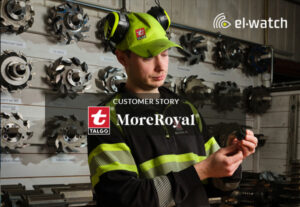Refrigeration monitoring is more important than ever. Our increasing global population has led to rising food demands and stricter food safety regulations. As a result, we see immense global food waste. Refrigeration temperature sensors enable us to safeguard food quality, reduce food waste, and increase food production sustainability.
There are many reasons for investing in refrigeration monitoring. That is to say, companies have different motivations, but they all want the same thing when investing in refrigeration temperature sensors: Stop wasting resources.
Many companies invest in refrigeration monitoring for financial reasons. Others do it for ideological reasons. Most companies tend to cite both reasons when scouting for suitable refrigeration temperature sensors. And why shouldn’t they when refrigeration monitoring improves both financial and environmental sustainability?
To learn more about the environmental benefits of IoT monitoring, check out our article «How wireless sensors enable a sustainable manufacturing industry». Or read on to get what you came for: Everything you need to know about refrigeration monitoring.
Content
- How do you monitor refrigerator temperature?
- How do refrigeration temperature sensors work?
- What is a refrigeration monitoring system?
- How does a refrigeration monitoring system work?
- What is the cold chain?
- What kind of temperature sensors are used in a refrigerator?
- What is the most accurate refrigeration temperature sensor?
- Which temperature sensor is best for refrigeration monitoring?
- Why do we need refrigeration monitoring?
How do you monitor refrigerator temperature?
Though thermometers and chart recorders have commonly monitored refrigerator temperature, modern food production requires more effective and accurate methods.
The food industry that caters to our growing global population is colossal. Keeping track of food stowing, transporting, and commercial storing is a massive undertaking, especially since food safety authorities require documentation of unbroken cold chains.
We’ll get back to cold chains in a little bit, but for now, let’s consider the workforce needed to measure and record the temperatures of our food production. Automation unlocks massive savings, improves accuracy, and eliminates human errors.
IoT refrigeration temperature sensors are quickly becoming the norm since they are easy to install, adapt and use in all kinds of freezers. They provide accurate, remote refrigeration monitoring around the clock that can be managed on smartphones.
How do refrigeration temperature sensors work?
Let’s get technical, just for a paragraph: Temperature sensor devices are electronic components sensitive to temperature changes and change their voltage or resistance accordingly. The small electrical changes are boosted in electronic circuitry, like op-amps, and usually digitized in an ADC to ease further processing.
In other words, refrigeration temperature sensors communicate by electric signals. For instance, El-Watch’s Neuron Temperature IP21 is an up-to-date wireless temperature sensor that meets modern food safety requirements.
Neuron Temp Air measures temperature every three seconds and rapports every two minutes. Management is easy via the Neuron Sensors App, where you can adjust settings, set alarms, check readings, and study data analysis.
Remote refrigeration monitoring can automate surveillance, eliminate human errors, and alert you of temperature anomalies. By IoT monitoring, Neuron Temp Air is also excellent for setting up refrigerator monitoring systems.
What is a refrigerator monitoring system?
A refrigeration monitoring system is a complete network for cold storage surveillance. The refrigeration monitoring system consists of several refrigeration temperature sensors, gateways, cloud solutions, and administrative software.
The purpose of a refrigeration monitoring system is to provide continual and accurate monitoring for analysis and reporting. Additionally, the system prevents accidental food waste by alerting administrators of unexpected temperature changes.
How does a refrigeration monitoring system work?
A refrigeration monitoring system surveils the temperature of several refrigeration sensors and transmits data to the cloud. Your management software uses this data to provide a wide range of insights and make logs for reporting to food safety authorities.
The refrigeration monitoring system ensures complete food safety chains, from food production and transport to catering businesses, restaurants, and wholesalers. The software identifies emerging patterns and potential problems along the way.
As such, a refrigeration monitoring system facilitates better food practices and spreads sustainability throughout the entire global food industry. Naturally, global sustainability requires local proficiency, which is why we must dive further into the details.
What is the cold chain?
The cold chain is all the links between cold-temperature perishables and consumers. Keeping the cold chain whole ensures user safety. The temperature must not rise above the damaging level in any links for the cold chain to remain unbroken.
Why do we need a cold chain?
Cold chain preservation ensures food safety, consumer satisfaction, and sustainable food production. Cold chain management is our best defense against food waste, bacterial growth, viral spread, and food poisoning.
What are the components of a cold chain?
The cold chain components vary depending on the point of origin and product type, but there are some common links. Typical cold chain components are packaging, transport, warehouse storage, handling, and commercial display.
What are the types of cold chains?
There are three types of cold chains: Passive, active, and hybrid cold chains. Passive cold chains keep perishables cold by phase change materials (PCM) like water, ice, or dry ice. Active cold chains use mechanics and electronics to maintain cold temperatures, while hybrid cold chains combine passive and active cooling methods.
How do you maintain a cold chain?
Cold chain preservation requires an accurate and stable refrigeration monitoring system. Constant surveillance and frequent reporting are necessary routines to maintain a cold chain. An appropriate alarm system is also beneficial.
What happens if you break the cold chain?
Broken cold chains lead to food waste, public health hazards, and financial losses. The consequences of broken cold chains are premature spoiling of merchandise, bacterial spreading, and less-than-optimal company profitability.
In short, broken cold chains are unsustainable. Every day, one food chain connects to each human’s food purchases. That is a lot of cold chains to maintain. So, forging unbreakable food chains will be a massive step toward sustainable food production.
What is the benefit of cold chain management?
Cold chain management has many worthwhile benefits for both businesses and consumers. First and foremost, it prevents food waste, which enforces sustainable food production and increases food producers’ profits.
Secondly, the spread of germs is avoided by proper cold chain management. Bacterial growth, viral spread, parasitic transmissions, food poisoning, and spoiling are all prevented by upholding food safety regulations and keeping cold chains unbroken.
Lastly, cold chain management keeps food quality consistently high, extending the product’s shelf life. An added consumer benefit is expanded access to fresh foods that have not degraded in appearance or taste.
What kind of sensors are used for refrigeration monitoring?
There are many kinds of temperature sensors, like thermometers, thermocouples, infrared sensors, silicon diodes, resistance temperature detectors (RTD), or negative temperature coefficients (NTC).
The latter (NTC) is known as thermistors, a common component in fridges and freezers worldwide. In the food industry, refrigeration monitoring is commonly performed by thermocouples due to their durability, responsiveness, and low price.
What is the most accurate refrigeration temperature sensor?
RTDs are the most accurate refrigeration temperature sensors, but they are also the most expensive. RTD sensors detect temperature changes from the changing resistance in a metal component.
Due to their accuracy, RTDs are commonly used for refrigeration monitoring in the chemical and pharmaceutical industry. However, due to its high cost, it is not widespread in the food industry.
Which temperature sensor is best for refrigeration monitoring?
Depending on your needs, different refrigeration monitoring sensors might be better options than others. If you need tremendous accuracy, RTDs are an excellent choice. An infrared thermometer is helpful if you need to measure surface temperature from a distance.
In the food industry, you typically need large numbers of affordable refrigeration monitoring sensors that are robust, reliable, and user-friendly. That is why most refrigeration monitoring in the food industry is done with thermocouples.
As for practical examples, Neuron Temp Air (NTC) offers accurate refrigeration monitoring. For frozen foods, Neuron Temp Air’s freezer room temperature control might suffice, but fresh food storage often requires more monitoring parameters.
Neuron Humidity monitors humidity and temperature, which is helpful for storing fresh fruits and vegetables. For meat storage, food safety is best maintained by simultaneously monitoring room temperature and the meat’s core temperature.
For this purpose, the Neuron PT100 covers all your needs. It measures the core temperature in meats every three seconds and reports every second minute. Together with Neuron Temp Air or Neuron Humidity, it provides total food safety control.
There is also much to gain from predictive maintenance in cold chain cooling systems. It gives you early warnings when cold chains are in danger of breaking due to faulty compressors, open doors, etc. Find out more in our article about predictive maintenance.
Why do we need refrigeration monitoring?
Simply put, refrigeration monitoring prevents food waste and ensures food safety. In addition, it surveils refrigeration system efficiency, which directly connects to energy consumption and company expenditures.
It makes perfect sense for any business in the food industry to follow food safety regulations. By installing refrigeration monitoring systems, you get fewer sales losses, energy-efficient cold storage, longer-lasting equipment, and lower power bills.
More importantly, you help create a sustainable food industry. Food safety is a must, but it needs to become more efficient to sustain our way of life, especially when we’ll get close to 10 billion people by 2050.
Resources
Atlas Scientific: How Do Temperature Sensors Work?
Centers for Disease Control and Prevention: How Food Gets Contaminated – The Food Production Chain
Emerald Insight: Food cold chain management: what we know and what we deserve
IEEE: Smart Refrigeration Equipment based on IoT Technology for Reducing Power Consumption
Intersam: The importance of maintaining the cold chain in the handling, transport, and storage of food
Research Square: A Smart IoT System for Remote Refrigeration Monitoring
The International Journal of HACCP and Food Safety: New trends in cold chain monitoring applications
Wireless Communications and Applications: Intelligent Monitoring System on Refrigerator Trucks Based on the Internet of Things
World Academy of Science, Engineering, and Technology: Performance Monitoring of the Refrigeration System with Minimum Set of Sensors





